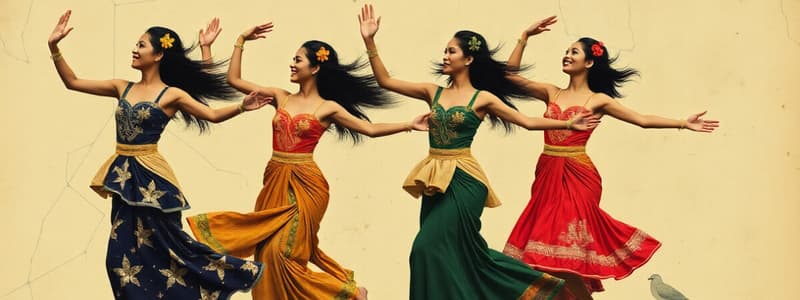Podcast
Questions and Answers
Which of the following factors significantly influenced indigenous dances in the Philippines?
Which of the following factors significantly influenced indigenous dances in the Philippines?
- European classical ballet
- The experiences and events in the community (correct)
- Trends in Europe during colonization
- American occupation dance forms
The American occupation led to a decrease in the variety of dance forms in the Philippines.
The American occupation led to a decrease in the variety of dance forms in the Philippines.
False (B)
Name two Afro-Cuban dance forms that gained popularity in the Philippines during the American occupation.
Name two Afro-Cuban dance forms that gained popularity in the Philippines during the American occupation.
Tango, samba, mambo, and cha-cha
A formal aerobic dance class typically consists of three phases: warm-up, aerobic dance, and ______ exercises.
A formal aerobic dance class typically consists of three phases: warm-up, aerobic dance, and ______ exercises.
Which of the following best describes modern ballet?
Which of the following best describes modern ballet?
Alice Reyes is known as the founder of ballroom dancing in the Philippines.
Alice Reyes is known as the founder of ballroom dancing in the Philippines.
What is a key characteristic of opera ballet that distinguishes it from other ballet forms?
What is a key characteristic of opera ballet that distinguishes it from other ballet forms?
Match the following dance types with their descriptions:
Match the following dance types with their descriptions:
Flashcards
Dance (Philippines)
Dance (Philippines)
Sharing talents and bonding within a community, often influenced by historical events.
Colonial Influence on Dance
Colonial Influence on Dance
Traditional dances changed with colonizers. Many indigenous rituals adapted to venerate Christian figures.
American Occupation
American Occupation
Introduced new dance forms such as tango, samba, mambo, and cha-cha. Also introduced popular crazes from the US like foxtrot, boogie woogie.
Aerobic Dance
Aerobic Dance
Signup and view all the flashcards
Aerobic Dance Class Phases
Aerobic Dance Class Phases
Signup and view all the flashcards
Ballet
Ballet
Signup and view all the flashcards
Modern Ballet
Modern Ballet
Signup and view all the flashcards
Opera Ballet
Opera Ballet
Signup and view all the flashcards
Study Notes
- Dance is a discipline that involves movement and self expression
Introduction
- Dance can be a way to bond and share talents with the rest of the community.
- Indigenous dances in the Philippines have been influenced and molded by various experiences and events in the community.
- War dances of the people of the mountain province reflect community experiences.
- With the arrival of colonizers, dancing traditions and forms changed, and many indigenous ritualistic dances were adapted to venerate figures of Christianity.
- Social dances were influenced by European trends.
- Examples of dances influenced by colonizers are pandango, polka, and the ballroom dance rigodon de honor.
- The American occupation introduced many dance forms, beginning contemporary dance.
- The Philippines was exposed to Afro-Cuban dance forms such as tango, samba, mambo, and cha-cha.
- Foxtrot, boogie woogie, mashed potato, and twist were popular dances and made their way to the different dance halls.
- European classical ballet was introduced in the early twentieth century.
- Filipinos were taught ballet, and the first generation of Filipino ballet dancers, teachers, and choreographers passed their skills and this is the basis for the continuing development of Philippine contemporary dance.
Aerobic Dance
- Aerobic dance is a dance routine made into an exercise program, usually accompanied by upbeat pop music.
- A formal aerobic dance class has three phases: warm up, aerobic dance, and cool down exercises.
- Variations include jazzercise, aero hiphop, ballroom dancing, and belly dancing.
Ballet
- Ballet is both dance and theater art as a dance technique that follows a strict set of moves and performance, originating in Europe.
- There are different contemporary reiterations of ballet form, these being modern ballet, opera ballet, and folkloric ballet.
- Modern ballet uses traditional techniques and style, incorporating a contemporary and sometimes experimental attitude.
- Alice Reyes (b.1942), is the founder of Ballet Philippines and a pioneer of modern dance.
- Examples of her works include Limang Dipa and Beautiful Girls.
- Opera ballet combines dance and song.
- Rock ballet is a more modern version of opera ballet.
- Mahal (1975) was created by Abel Labrador, Mon Faustmann, Rahissa lahat-wala, and Julie and Rose Borromeo.
- Folkloric ballet is performance that presents subjects and themes based on the art and culture of a community.
- Examples include Agnes, Tapestry/Bayanihan.
Folk Dance
- Folk dances differ depending on various cultural groups throughout the country as it changes from region to region.
- Mimetic dances are folk dances that imitate animals, such as the Kadal Bleah of the T’boli.
- Mimetic dances copy communal activities like planting and harvesting.
- Ethnic groups use these traditional dances to celebrate their identity and are based on their literature, legends, and beliefs.
Street Dance
- Street dance describes vernacular dances that developed organically within a community.
- The dance began in urban spaces, such as parks and streets.
- Early forms of street dancing gained popularity during the late 1970s.
- Street dance is improvisational and social in nature, encouraging interaction between audience members and other dancers.
- A popular street dance routine is hip-hop.
- This dance form is popular with the youth.
Studying That Suits You
Use AI to generate personalized quizzes and flashcards to suit your learning preferences.




